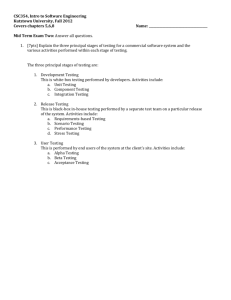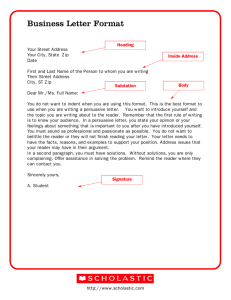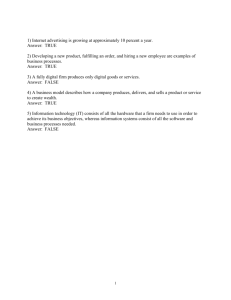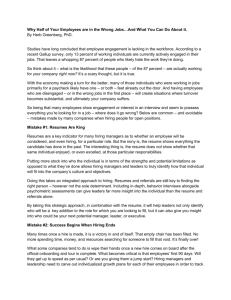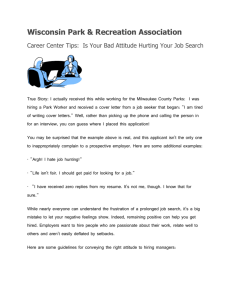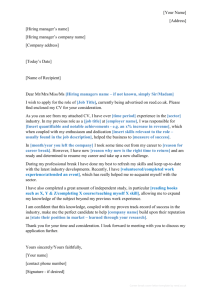Cover Letters (Word document) - Office of the Provost
advertisement
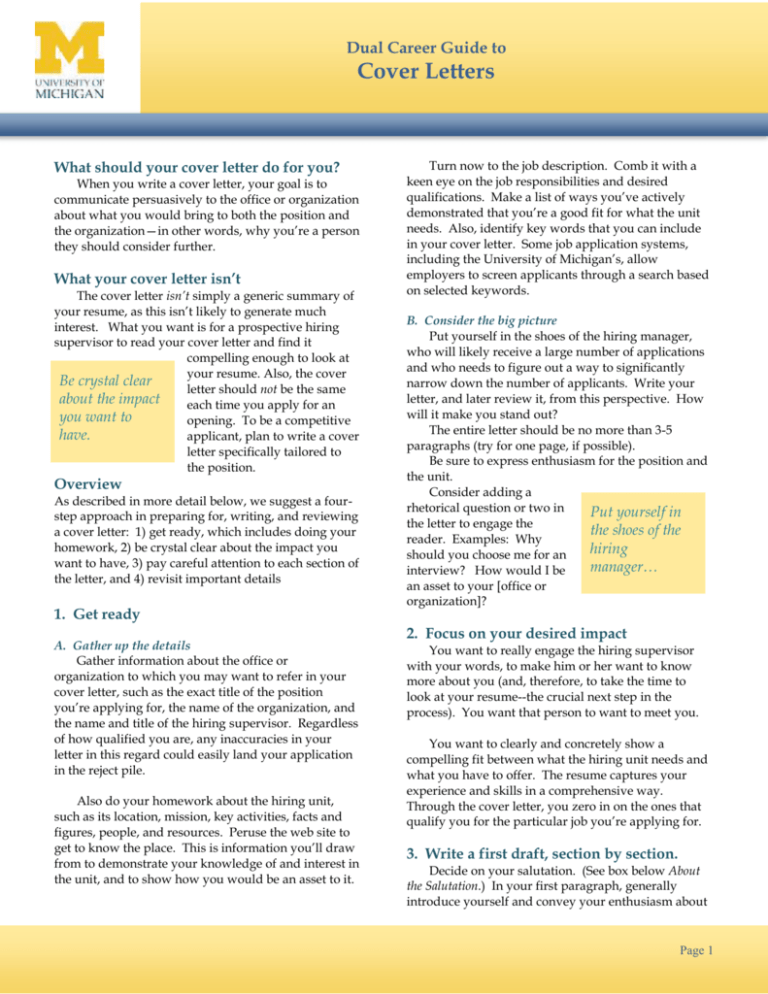
Dual Career Guide to Cover Letters What should your cover letter do for you? When you write a cover letter, your goal is to communicate persuasively to the office or organization about what you would bring to both the position and the organization—in other words, why you’re a person they should consider further. What your cover letter isn’t The cover letter isn’t simply a generic summary of your resume, as this isn’t likely to generate much interest. What you want is for a prospective hiring supervisor to read your cover letter and find it compelling enough to look at your resume. Also, the cover Be crystal clear letter should not be the same about the impact each time you apply for an you want to opening. To be a competitive have. applicant, plan to write a cover letter specifically tailored to the position. Overview As described in more detail below, we suggest a fourstep approach in preparing for, writing, and reviewing a cover letter: 1) get ready, which includes doing your homework, 2) be crystal clear about the impact you want to have, 3) pay careful attention to each section of the letter, and 4) revisit important details 1. Get ready A. Gather up the details Gather information about the office or organization to which you may want to refer in your cover letter, such as the exact title of the position you’re applying for, the name of the organization, and the name and title of the hiring supervisor. Regardless of how qualified you are, any inaccuracies in your letter in this regard could easily land your application in the reject pile. Also do your homework about the hiring unit, such as its location, mission, key activities, facts and figures, people, and resources. Peruse the web site to get to know the place. This is information you’ll draw from to demonstrate your knowledge of and interest in the unit, and to show how you would be an asset to it. Turn now to the job description. Comb it with a keen eye on the job responsibilities and desired qualifications. Make a list of ways you’ve actively demonstrated that you’re a good fit for what the unit needs. Also, identify key words that you can include in your cover letter. Some job application systems, including the University of Michigan’s, allow employers to screen applicants through a search based on selected keywords. B. Consider the big picture Put yourself in the shoes of the hiring manager, who will likely receive a large number of applications and who needs to figure out a way to significantly narrow down the number of applicants. Write your letter, and later review it, from this perspective. How will it make you stand out? The entire letter should be no more than 3-5 paragraphs (try for one page, if possible). Be sure to express enthusiasm for the position and the unit. Consider adding a rhetorical question or two in Put yourself in the letter to engage the the shoes of the reader. Examples: Why hiring should you choose me for an manager… interview? How would I be an asset to your [office or organization]? 2. Focus on your desired impact You want to really engage the hiring supervisor with your words, to make him or her want to know more about you (and, therefore, to take the time to look at your resume--the crucial next step in the process). You want that person to want to meet you. You want to clearly and concretely show a compelling fit between what the hiring unit needs and what you have to offer. The resume captures your experience and skills in a comprehensive way. Through the cover letter, you zero in on the ones that qualify you for the particular job you’re applying for. 3. Write a first draft, section by section. Decide on your salutation. (See box below About the Salutation.) In your first paragraph, generally introduce yourself and convey your enthusiasm about Page 1 Dual Career Guide to Cover Letters the job. To immediately capture the interest of your reader, make your first sentence a compelling one. Grab the reader’s attention but also say right away why you’re a good candidate for the job. In the next one to two paragraphs, describe how you’re a good fit for the job with some examples drawn from your experience. Also address how you share the organization’s goals and interests—why you would be a good fit. To immediately capture the interest of your reader, make your first sentence a compelling one. Grab the reader’s attention… Your final paragraph should include a quick summary, a closing, and an expression of thanks. Some points to consider You may wish to include a “Subject:” or “Re:” line in your letter, which you should place directly below your salutation to identify the specific job you’re applying for. This can be especially helpful when an office has posted more than one position at the same time. Mention your plans to relocate and when-especially if your resume and cover letter list an out-oftown address. If you know when you’ll be in town for a campus visit, also include this information. It is best to steer clear of mentioning that you are a dual career partner. Focus instead on you and your strengths. Although you may think letting the reader know you’re part of a dual career couple might be helpful, it doesn’t have any bearing on whether you’re qualified for the position, which should be your focus. Avoid apologizing or expressing anything in the negative. Instead, stick with the positive. “You indicate the need for…” to bring your fit with the job to the forefront of the letter. Some applicants have successfully used a twocolumn approach in the body of the letter, with a short “You Need” list on the left and a parallel “I Offer” list on the right that shows how you’ve demonstrated those skills. This approach is nontraditional but can be effective. Example: http://www.quintcareers.com/sample_two_column_l etter.html 4. Review and revise For accuracy, double (or even triple) check your grammar, your spelling, and your information. Even a single mistake could jeopardize your application. Read your letter out loud. This is one of the best ways to critique your own writing. Do you get enthusiastic reading it? If not, figure out to how to add more punch. Also, it’s important for your writing to be genuine, for it to reflect who you are. Is this so? If not, the reader is likely to pick up on it. Ask a trusted friend or colleague—someone who can be objective and not worry about hurting your feelings—to read your draft and give you feedback. Ask pointed questions. How could you make the letter more persuasive? How could you more actively engage the reader? How could you make the letter more interesting to read? Tell a more compelling story about you? Use language that’s more alive? Read your letter out loud. This is one of the best ways to critique your own writing. Do you get enthusiastic reading it? As you write, make sure to vary your sentence structure. If every sentence begins with “I,” then you probably haven’t successfully addressed the organization’s needs in your letter. Consider adding sentences that begin “Your job posting notes…” or Page 2 Dual Career Guide to Cover Letters Online Resources Sample Dynamic Cover Letters for Job Seekers (Quintessential Careers): http://www.quintcareers.com/cover_letter_samples.html More than 40 sample cover letters of varying types. “Dynamic Cover Letters Tutorial For Developing a Stunningly Effective Cover Letter,” offered by Quintessential Careers http://www.quintcareers.com/cover_letter_tutorial.html (Includes link to a detailed site map for easy navigation.) About the Salutation First, make every effort to figure out the name of a person to whom you can address your letter. Use the Internet to your advantage. If you successfully identify either the person in charge of hiring, or a person in a leadership role in the department, company, or organization, the results will set you apart from all those applicants who didn’t take the time. If you are applying for a position within the University of Michigan, a member of the dual career team can provide the name of the hiring manager so that you can address your letter specifically. Depending on the workplace environment, you may wish to use certain titles in place of Mr. or Ms., such as Professor, Dr., Dean, Senator, Governor, Captain, Judge, and such titles as Sister or Rabbi. If you’re unsure of the person’s gender, you may wish to use both names, as in “Dear [first name] [last name]:” If there is no useful information available, then you can use “Dear Hiring Manager,” or “Dear Search Committee.” Because many people find “Dear Madam/Sir” and “To Whom It May Concern” to be out of date and stilted, we recommend against using them. http://www.quintcareers.com/networking_business_cards.html Page 3
